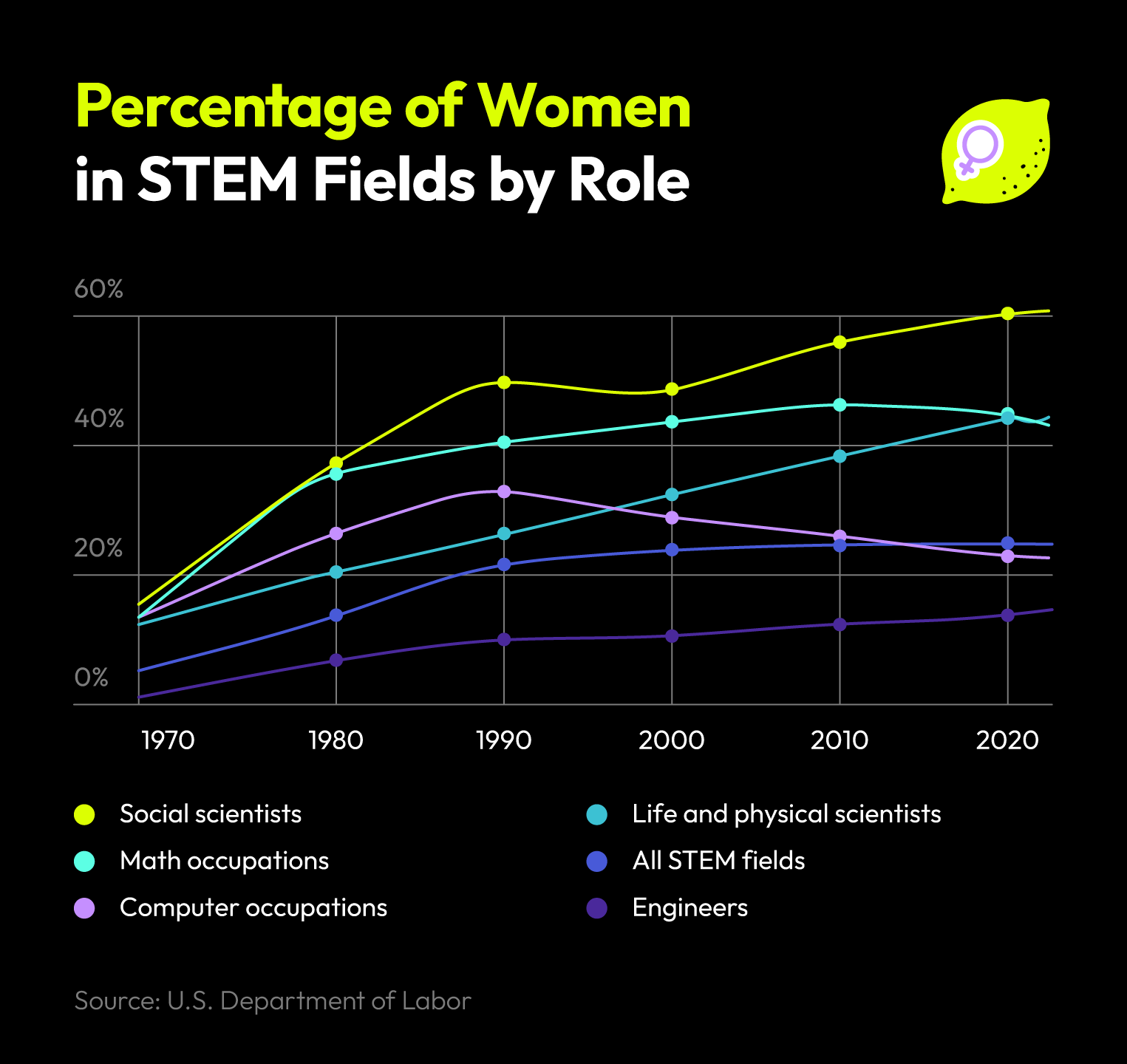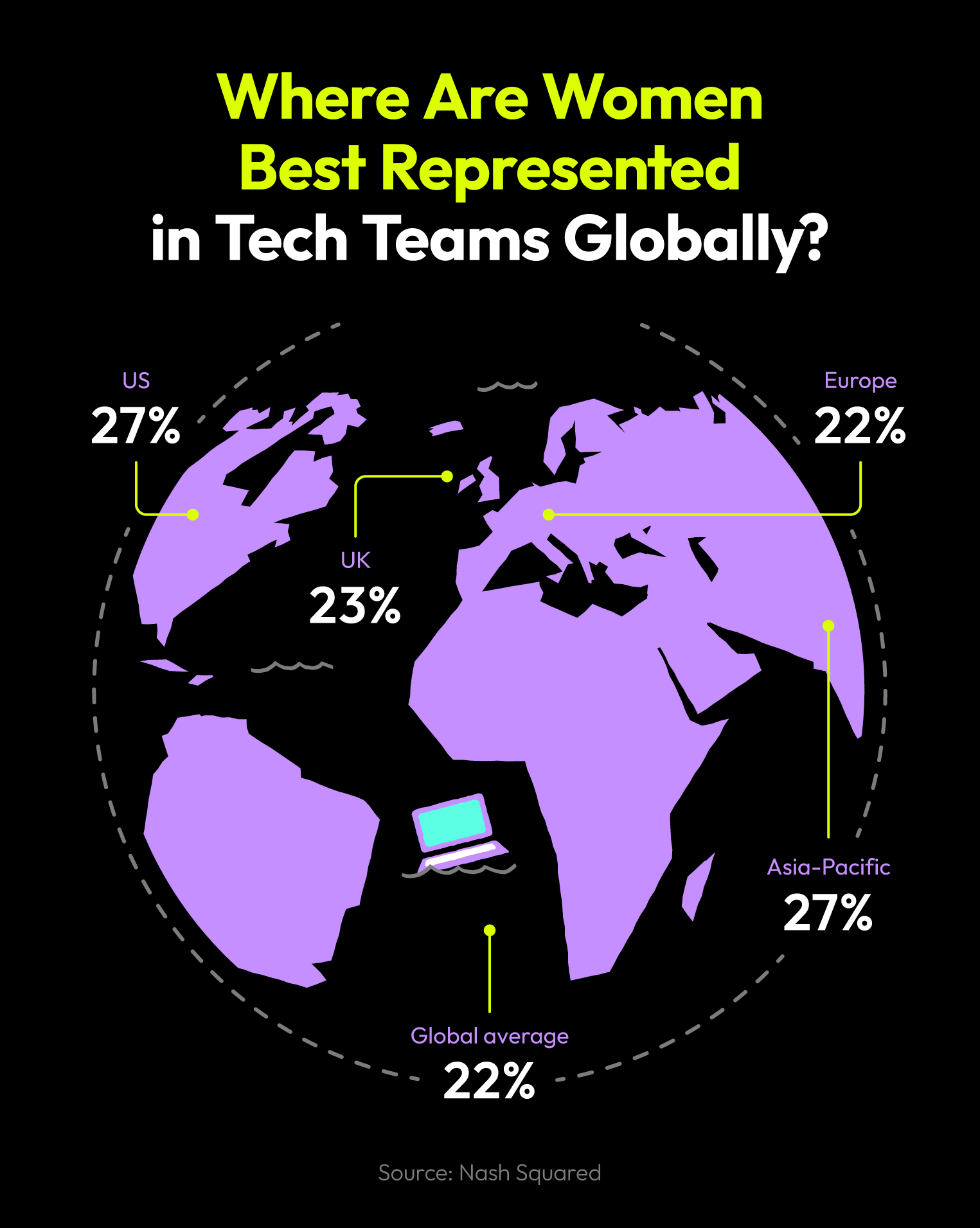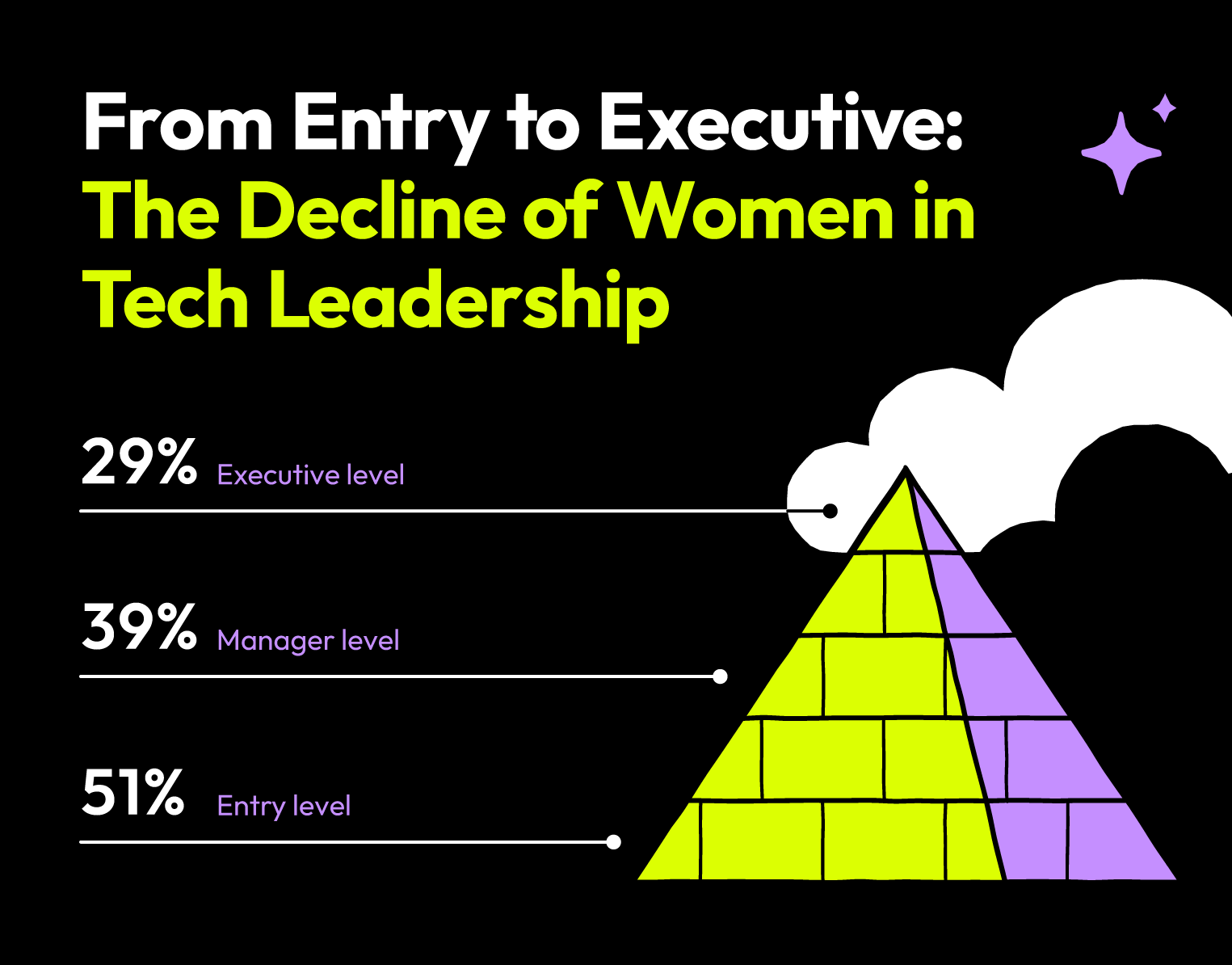Quick Insight:
Women remain underrepresented in tech leadership and core roles, with only 26% in STEM and fewer in AI, engineering, and executive positions.
Women make up nearly half the U.S. workforce, but representation in tech still lags far behind. According to recent women in tech statistics, only about one in four STEM workers is female, and even fewer hold roles in engineering, AI, or senior leadership.
For companies building the next generation of digital products, this gap represents more than just a diversity in tech problem. It’s a missed opportunity for innovation, performance, and long-term team health.
In this report, we break down the latest women in tech statistics, explore the barriers they face, and highlight the trends that suggest change is underway.
Key Trends
- Women remain underrepresented in tech leadership and core roles, with only 26% in STEM and fewer in AI, engineering, and executive positions.
- Systemic barriers persist, including gender bias, pay gaps, and a lack of mentorship or advancement opportunities.
- Positive momentum is growing, driven by DEI initiatives, pay equity audits, and rising STEM graduation rates among women.
Representation of Women in Tech and STEM
While women make up nearly half of the U.S. workforce, the tech industry still tells a very different story. Women in STEM statistics, and especially in technical, AI, and leadership roles, continue to lag behind.
The numbers show that while more women are entering the field, progress has been uneven and often stalls the higher up you go.
Overall Representation
Across the industry, female representation in tech remains low despite rising awareness and diversity efforts. At many of the biggest names in tech, men still outnumber women three to one in technical roles.
For example, according to Deloitte’s 2024 Women in Tech report, women make up just 25% of the technical workforce at companies like Google, Apple, and Meta.
Even in non-technical roles, inclusion rates rarely exceed 30%. In 2022, less than 23% of tech workers were women, even though they make up nearly half of the U.S. workforce.
In the broader U.S. STEM workforce, women made up only 26% of employees in 2022, per U.S. Census Bureau data.
Even though degree completion is climbing, only 21% of engineering and 22% of computing degrees were awarded to women in 2023, based on National Science Foundation findings.
Globally, the gap is even more stark in emerging fields. According to the Stanford AI Index 2024, women hold just 22% of AI roles and only 18% of AI researchers worldwide. Meanwhile, Accenture’s report notes that just 28% of tech leadership roles globally are held by women, and only 16% are CTOs.
These numbers reflect the everyday experiences of millions of women navigating underrepresentation in classrooms, boardrooms, and codebases.
Representation at Different Experience Levels
Even when women enter the tech pipeline, many don’t stay. Representation drops significantly with each step up the ladder, a phenomenon often described as the “broken rung.”
At the entry level, things look more promising: Women make up about 51% of roles across all industries, but the number is closer to 29% in tech.
Coding bootcamps and tech internships are slowly improving the numbers, with platforms like Code.org reporting that female participation in early-career tech education now hovers around 25-30%.
However, the drop-off is sharp once women move into mid- and senior-level positions.
LeanIn’s 2024 Women in the Workplace report shows that only 39% of managerial roles in tech are held by women, and women of colour face even steeper odds, making up just 4-5% of all senior STEM roles according to the AAUW.
At the executive level, representation becomes especially scarce. Women currently hold just 28% of senior vice president roles and 29% of C-suite positions in tech.
Despite slow gains, these stats underscore a sobering reality: women in tech are both underrepresented and underpromoted. Tackling this isn’t just about increasing entry numbers.
It’s about fixing the systemic issues that push women out before they reach leadership, from lack of mentorship to unequal pay and bias in promotion paths.

Hiring Trends and Retention for Women in STEM
Women are gaining ground in STEM fields, but hiring and retention metrics reveal persistent gaps and systemic challenges in the tech industry.
The following trends show where representation falls short and where progress is most critical for employers.
- Low overall representation despite growth: Women made up just 26% of U.S. STEM employees in 2022, only a one-percentage-point increase since 2000, highlighting slow progress even as degree attainment rises.
- The gap widens at larger employers: Among major tech firms and Fortune 500 companies, female representation in STEM roles hovers between 20-25%, underscoring that larger organizations lag in inclusive hiring compared to smaller ones.
- Equity gap in assignment and advancement: Only 23% of women cite lack of career opportunities as a barrier, and 24% say structural obstacles halt their STEM trajectory.
- Persistent pay gap in STEM roles: Women in STEM earn about 99 cents to every dollar men make, with gaps wider in engineering and science, where it drops to 87 cents in science and 90 cents in engineering as of 2024 data.
These statistics reinforce the need for employers to prioritize inclusive recruiting, transparent promotions, and equitable pay to improve retention and representation.
Challenges Women Face in Tech Roles
Women in tech continue to encounter systemic obstacles that impact hiring, career growth, and well-being. These barriers not only hinder individual success but also limit team performance.
Below are five major challenges based on recent data and studies:
- Gender bias and discrimination remain widespread: Around 57% of women in tech report experiencing gender-based discrimination, with 48% facing bias over technical abilities, compared to just 10% of men.
- Work-life balance concerns drive attrition: Nearly 45% of women in tech cite poor work-life balance as a top reason for leaving a job, and over half of women fear flexing schedules will hurt their career progression.
- Bro culture creates exclusionary norms: Women report being isolated by a “bro code” culture, marked by sexist jokes, dominance, and even harassment.
- Few female role models in senior positions: Women make up only about 29% of C-suite roles and 28% of senior vice president positions in large tech companies. This creates a lack of visible leadership for junior women to emulate.
- Representation drops sharply at higher career levels: While women represent nearly 51% at the entry level, their presence shrinks to just 39% at the manager level and down to 29% in executive positions, revealing a significant “broken rung” in progression.

Positive Trends for Women in Tech
While gender gaps remain, several encouraging trends point to real progress for women in the tech industry:
Increased Awareness
Corporate and public attention on gender equity has grown steadily. According to Women in Tech Network, women made up less than a third of the tech workforce between 2019 and 2023, signaling a gradual recovery from earlier declines.
Additionally, a 2024 Deloitte study found that 91% of organizations are now actively promoting women in tech, up from just 76% in 2019.
DEI Initiatives
Many tech companies are implementing structured DEI programs. Employee resource groups (ERGs) for women are growing in number and influence, with WomenTech Network reporting that 68% of women now participate in at least one ERG.
Companies like Cisco are also tying executive bonuses to diversity in technology outcomes, ensuring accountability at the highest level.
Pay Equity Policies
Some firms are tackling pay gaps head-on. Research from SHRM revealed that 75% of surveyed companies say they conduct annual pay equity audits.
This signals a shift from policy to measurable action in industries where there were once large wage disparities.
Scholarships & Support for Underrepresented Groups
Scholarship programs for girls in STEM are expanding globally. The Society of Women Engineers (SWE) now awards over $1 million annually, and initiatives like Women in Data Science (WiDS) workshops attracted more than 150,000 participants worldwide in 2024.
These programs are helping diversify AI and data science pipelines, with many attendees reporting increased confidence in pursuing STEM careers.
Higher Ratio of Women Graduating with STEM Degrees
Female graduation rates in STEM fields are now reaching parity in many disciplines. According to the National Science Foundation, women earned about a third of degrees at every level in general STEM in 2023.
However, computing and engineering still lag, with only about 21-22% female graduates, though these numbers continue to climb steadily year over year.
Women in Tech and AI
The intersection of women in tech and AI highlights both progress and risk. Globally, women hold just 22% of AI roles, signaling a persistent gender gap even as AI becomes central to innovation.
In North America, female representation improved slightly to 25%, but leadership and research positions remain elusive for many women.
Here are some notable insights about women in tech and AI:
- A 2024 analysis found women make up only 29% of the AI workforce at leading tech firms, with men constituting the remaining 71% of AI-skilled roles.
- Among AI researchers worldwide, that number drops further to 18%, underlining the scarcity of women at the forefront of technical development.
- Despite this imbalance, AI presents new opportunities: A 2024 Skillsoft report reveals that 40% of women in tech are using Gen AI at work, and 73% consider it improved their productivity.
- Yet Deloitte revealed that comfort with AI tools lags behind men; just 34% of women use AI daily vs. 43% of men suggesting a gap in both adoption and confidence.
- Compounding the issue, women are 25% less likely to have basic digital skills than men, making them more vulnerable to automation and delaying their full engagement with AI-driven roles.
AI is reshaping tech products and the demographics of the tech workforce. Women’s growing adoption of generative AI shows promise, but systemic gaps in training, access, and inclusion must be addressed.
Supporting confidence-building and skill development is key to empowering women to fully participate in AI’s development and benefits.
How Women Can Get Ahead in Tech
Advancing in tech requires both strategy and support. Here are five actionable steps women can take to accelerate their careers, backed by recent trends and data:
1. Seek Mentorship and Sponsorship
According to LinkedIn’s Workforce Diversity Report, women who engage regularly with mentors report 33% higher job satisfaction and 25% faster promotion rates.
Choosing mentors who can advocate for your growth and visibility within your organization lays a strong foundation for advancement.
2. Build Networks Through Professional Groups
Joining women-led communities like Jordan Dea’s Women Tech Network or GitHub’s Women in Tech provides access to peer support, skill sharing, and job opportunities.
Data from an IEEE study shows participants in these groups are twice as likely to apply for mid-to-senior roles.
3. Invest in Continuous Learning, Especially in High-Demand Areas
Women already in tech should upskill in fields like AI, cybersecurity, software project management, and cloud computing.
According to LinkedIn’s 2024 Workplace Learning Report, women who earn certifications in these domains see their annual salaries increase by 15-20%.
4. Negotiate Roles and Compensation Early
While men are usually more successful at negotiating salaries, women can improve their financial prospects by being proactive about it.
Hiring experts are still encouraging women to negotiate for fair salaries, and cite that many are still afraid to do so.
How Businesses Promote Women in Tech
Building a truly inclusive tech team requires proactive strategies. Here are key approaches companies are successfully using, backed by recent software development insights:
Addressing Gender Bias in Hiring
Leading firms are eliminating gender-coded language from job listings, implementing blind resume reviews, and using structured interview methods to reduce bias.
Companies like Google saw a 5% increase in female hires after introducing more diverse interview panels and standardized assessments through these changes.
Fostering Inclusive Work Environments
Organizations prioritizing belonging, through mentorship, flexible schedules, and fairness training, retain female talent more effectively.
Tech leaders who actively prioritize DEI usually see improved innovation and employee satisfaction.
Developing Women’s Leadership Skills
Empowering women through leadership programs and role rotations builds a pipeline for senior roles.
Cisco links executive pay to diversity goals and reports lower attrition thanks to job-swapping opportunities and leadership accelerators.
Recognizing and Showcasing Success Stories
Visibility matters. Highlighting female leaders in company channels and inviting them to speak at events helps normalize diversity.
For example, Logitech’s Delphine Donné attributes her rise to a sponsorship culture and diverse team visibility at the company.
Ultimately, these strategies go beyond quotas, creating environments where women can thrive and where businesses benefit from broader perspectives and stronger performance.

Hire Your Next Developer from Lemon.io
Looking at recent women in tech statistics, it’s clear that while representation has improved, challenges around hiring, retention, and leadership access remain.
From gender bias in hiring to gaps in pay and career advancement, the data shows why building diverse teams requires more than intent. It takes action.
For companies navigating these challenges, understanding how to hire a software developer with diversity in mind is a smart first step.
Lemon.io connects companies with skilled, vetted developers from around the world, making it easier to build balanced teams without compromising on quality.
Hire developers through Lemon.io and build a stronger, more diverse tech future starting today.
FAQ
Is There a Female Bias in the Tech Industry?
Yes, gender bias remains a significant issue in tech. Women often face skepticism around their technical abilities, are underrepresented in leadership roles, and receive less credit for their work than their male peers.
What Are the Struggles of Women in Tech?
Common challenges include gender bias in hiring and evaluations, limited access to mentorship, wage inequality, and exclusion from leadership pipelines. Many also face workplace cultures that undervalue flexibility or fail to address subtle forms of discrimination.
What Is the Gender Ratio in Technology?
As of 2025, women make up roughly 26% of the STEM workforce in the U.S. and around 24% of roles in core tech fields like computing and engineering. Representation drops further at senior and executive levels.
What Is the Gender Gap in the Tech Industry?
The gender gap refers to disparities in hiring, pay, leadership, and opportunity between men and women in tech. While women are earning more STEM degrees, they continue to face systemic barriers once they enter the workforce, especially in promotions, pay equity, and representation in technical leadership roles.









